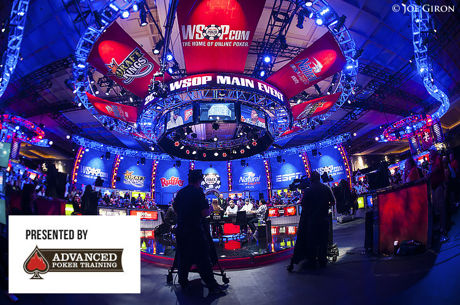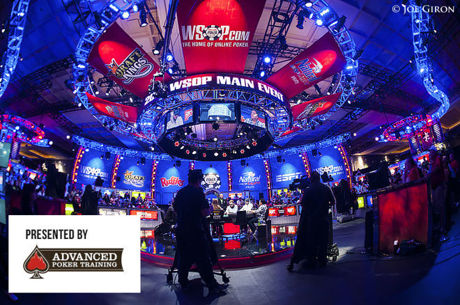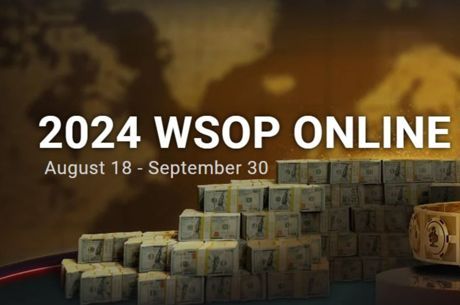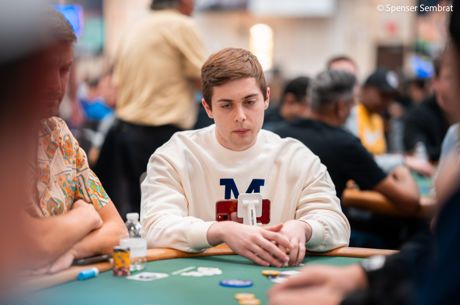Simulating The November Nine Part 3: How To Win The Main Event
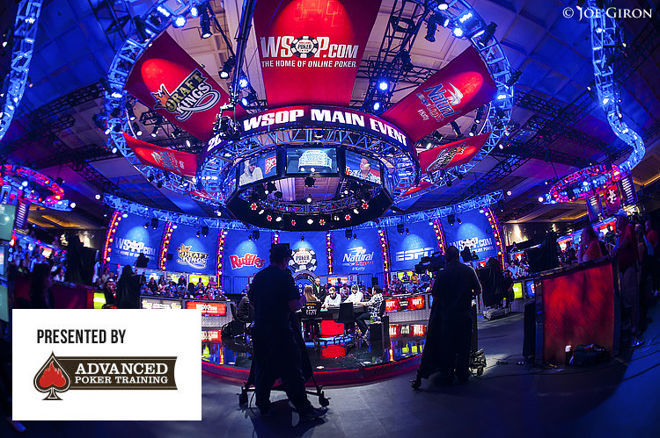
We are now just a little over a week away from the conclusion of the 2016 World Series of Poker Main Event. The final table will begin October 30, but in advance, PokerNews and Advanced Poker Training has run a series of November Nine simulations in an attempt to provide some insight into what might happen.
We used the information from our player bios to come up with a playing style for each of this year's November Nine. Then we took the Advanced Poker Training software, which allows users to play in simulated games against artificial intelligence bots, and created individual bots for each of the players. Eventually, we let those bots loose against one another in real-life Main Event parameters.
APT bots are built to play like real humans, and while the November Nine bots were not perfect clones, they were designed to emulate the style of play of each of the 2016 November Nine by mapping the information about each one to 42 different configurable traits. Some human-like characteristics were also tossed in, including how each would react to the pressure of playing for a World Championship in front of an audience of millions.
Two predictions were made, including the number of wins each player would have based on stack sizes as a percentage of the total chips in play and the average number of dollars won, using the Independent Chip Model (ICM). We ran a total of 100 simulations.
The player bios, more on the process and the entire results can be found in Part 1 of the series.
A look at a number of key hands that led to the Cliff Josephy bot winning less and the Qui Nguyen and Fernando Pons bots winning more than predicted were replayed and analyzed in Part 2 of the series.
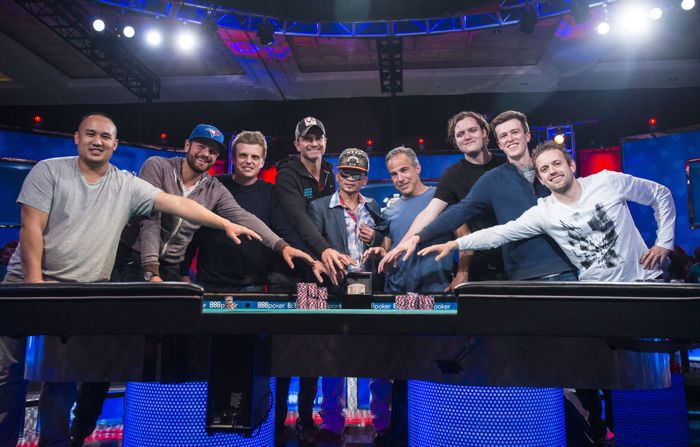
For the third part of the series, PokerNews asked APT's Director of Operations and original software developer Steve Blay to analyze the play of each bot, giving us its individual keys to winning and pitfalls to avoid:
| Cliff Josephy |
|---|
| Winning Strategy: When it was successful, the Josephy bot used his chip lead and experience to put pressure on his opponents. It also adjusted back to a tight-aggressive style when things weren��t going well. Evidence of this is that the bot finished in the top four 77 percent of the time, which is even more often than the overall money winning Qui Nguyen bot managed to do. Plus, he never finished in eighth or ninth place, which no other bot can claim. |
| What to Avoid: In our simulations, the Josephy bot had too many big confrontations with the Nguyen and Gordon Vayo bots early on. The Nguyen bot is known as a gambler and the Vayo bot has been known to play loose-aggressive at times as well. Also, since they know each other, the Vayo bot was less likely to let Josephy bully him around. One adjustment the Josephy bot could have made would have been to be a bit more selective and target the smaller stacks instead. |
| Qui Nguyen |
|---|
| Winning Strategy: In our simulations, the Nguyen bot pounced on opponents who were playing timidly. It became evident that the bot should use his reputation as a gambler to make other players fear confrontations with him. It should make other players think twice before raising, because it is always a threat to shove on them. |
| What to Avoid: The Nguyen bot had 30 percent more first-place wins than expected in our sims; however, it was only up nine percent in total prize money. Translation: It crashed and burned quite often. The bot needs to temper the aggression, pick the right spots and remember the Main Event final table isn��t an all-or-nothing proposition. |
| Gordon Vayo |
|---|
| Winning Strategy: The Vayo bot should take the solid approach and avoid big confrontations. Using this strategy, the bot outperformed its predicted money win by five percent in our simulations. It also finished in the top three well over half the time. |
| What to Avoid: Vayo��s history as an online player indicates a need to make sure he stays patient. As designed, the bot walked the line between a loose-aggressive and tight-aggressive player most of the time �C but accourding to our sims, it should really try to stay on the tighter side of that line. If the bot lets the looser players annihilate each other, it easily ladders up to the top three where the big money sits. |
| Kenny Hallaert |
|---|
| Winning Strategy: Much like Vayo, the Hallaert bot was effective playing a tight-aggressive style in our simulations. It finished in the top three an impressive 45 percent of the time and overall won three percent more prize money than expected. |
| What to Avoid: While Hallaert is an experienced player and the bot was designed to play like one, he can��t possibly have logged nearly as many hours as Josephy or Vayo. As a result, the bot performed best when avoiding deep post-flop confrontations with those two, where experience often wins out. |
| Michael Ruane |
|---|
| Winning Strategy: Ruane is also an experienced online player. Given that the bot started with the median chip stack (fifth place), its strategy should be clear: Try to play aggressively against the short stacks, while avoiding the big stacks. The bot was ineffective at doing this in our simulations, hindered by a table draw that included two out of the four stacks bigger directly on his right and the other two on its immediate left. |
| What to Avoid: The Ruane bot started off playing too tightly in our simulations, often losing a lot of chips in the first couple levels. It gradually started to loosen up, but didn��t recover often enough. It started out fifth in chips, but still finished in sixth place or worse nearly 50 percent of the time as a result. |
| Vojtech Ruzicka |
|---|
| Winning Strategy: Similarly to Ruane, the Ruzicka bot struggled early on in our simulations, and was also hindered by the table draw. Once the Fernando Pons bot got eliminated, he had nothing but mountainous stacks to his left. Further research would be needed to find an optimal strategy for Ruzicka. The bot may have no choice but to play ultra-tight given the aforementioned table-draw problem. |
| What to Avoid: Ruzicka seems uncomfortable being in the spotlight and needs to make sure nerves don��t become a factor. This factor was incorporated into the simulation and perhaps contributed to him underperforming expectations by four percent. |
| Griffin Benger |
|---|
| Winning Strategy: When given the opportunity, the Griffin bot tried to slowly build up chips from the short stacks seated around him. The bot was able to re-steal often from the players on his right, including Ruane, Vayo and Hallaert. Benger starts with enough chips that an all-in confrontation would cripple any of them and they all want to avoid that. It won��t be easy, but Benger is one of the most experienced players in the bunch, so if anyone can do it, he can. |
| What to Avoid: The Benger bot had the most difficulty of all players in our simulations, winning 12 percent less prize money than expected. The bot was not able to effectively implement the game plan mentioned above. Only time will tell if the real Griffin Benger will succeed. As far as the bot is concerned, it was admittedly difficult to implement the strategy above in code. |
| Jerry Wong |
|---|
| Winning Strategy: Plain and simple: Wong needs to double up early on. Then he will have enough chips to play a reasonable game. |
| What to Avoid: In our sims, Wong went out in eighth or ninth place over 50 percent of the time. Looking back, perhaps the bot got too extreme with trying to double up early on. On the flip side, the prize jumps are so small initially, perhaps it��s worth the gamble to try to double up. I��m sure Wong will be crunching some numbers on this. |
| Fernando Pons |
|---|
| Winning Strategy: The Fernando Pons bot shocked us all by winning 19 percent more prize money than expected in our simulations and even won it all five times. With the blinds starting at 250K/500K, there is no question Pons needs to double up a couple times and he won��t have the chips to wait for the perfect situation. It isn��t surprising that he went out in ninth place 40 percent of the time in our simulations and finished in the bottom three places 74 percent of the time. However, he wasn��t afraid to gamble it up at any point in the tournament and that strategy paid off. |
| What to Avoid: While the Pons bot took first place five times, his overzealous play made him unsuccessful at reaching the other top places effectively (second place: four times, third place: zero times). Perhaps the bot could have been improved by showing some restraint once it doubled up once or twice. It might not have won five times, but it could have added a much greater number of top-three finishes and might have won more prize money overall. |
Next week, leading up to the live Main Event final table, we will recap the entire Simulating The November Nine series.

